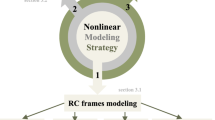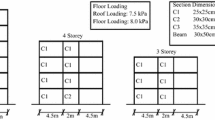Abstract
Masonry buildings are primarily constructed out of bricks and mortar which become discrete pieces and cannot sustain horizontal forces created by a strong earthquake. The collapse of masonry walls may cause significant human casualties and economic losses. To maintain their integrity, several methods have been developed to retrofit existing masonry buildings, such as the constructional RC frame which has been extensively used in China. In this study, a new method using precast steel reinforced concrete (PSRC) panels is developed. To demonstrate its effectiveness, numerical studies are conducted to investigate and compare the collapse behavior of a structure without retrofitting, retrofitted with a constructional RC frame, and retrofitted with external PSRC walls (PSRCW). Sophisticated finite element models (FEM) were developed and nonlinear time history analyses were carried out. The results show that the existing masonry building is severely damaged under occasional earthquakes, and totally collapsed under rare earthquakes. Both retrofitting techniques improve the seismic performance of existing masonry buildings. However, it is found that several occasional earthquakes caused collapse or partial collapse of the building retrofitted with the constructional RC frame, while the one retrofitted by the proposed PSRC wall system survives even under rare earthquakes. The effectiveness of the proposed retrofitting method on existing masonry buildings is thus fully demonstrated.
Similar content being viewed by others
References
Cai JF (1984), Seismic Damage of Multi-Story Masonry Buildings in Tangshan, Tsinghua University Press, Beijing, China. (in Chinese)
Caliò I, Marletta M and Pantò B (2012), “A New Discrete Element Model for the Evaluation of the Seismic Behaviour of Unreinforced Masonry Buildings,” Engineering Structures, 40: 327–338.
Charleson A and Blondet M (2012), “Seismic Reinforcement for Adobe Houses with Straps from Used Car Tires,” Earthquake Spectra, 28(2): 511–530.
Chen ZY (2009), Disaster and Countermeasures of Buildings During Wenchuan Earthquake, China Building Industry Press, Beijing, China. (in Chinese)
Dai J, Qu Z, Zhang C and Weng X (2013), “Preliminary Investigation of Seismic Damage to Two Steel Space Structures During The 2013 Lushan Earthquake,” Earthquake Engineering and Engineering Vibration, 12(3): 497–500.
ElGawady M, Lestuzzi P and Badoux M (2004), “A Review of Conventional Seismic Retrofitting Techniques for URM,” 13th Brick & Block Masonry Conf., Amsterdam, 9: 1–9.
FEMA P695 (2009), “Quantification of building seismic performance factors,” ATC 263 Project Report.
Gu XL, Peng B, Chen GL, Li X and Ouyang Y (2012), “Rapid Strengthening of Masonry Structures Cracked In Earthquakes Using Fiber Composite Materials,” Journal of Composites for Construction, ASCE, 16(5): 590–603.
Hakuno M and Meguro K (1993), “Simulation of Concrete-Frame Collapse due to Dynamic Loading,” Journal of Engineering Mechanics, 119(9): 1709–1723.
Lemos JV (2007), “Discrete element Modeling of Masonry Structures,” International Journal of Architectural Heritage, 1(2): 190–213.
Li J (2013), “The Collapsed Factors Analysis of Masonry Structures and Preliminary Exploration about Anti-collapse Based Numerical Simulation,” Master Dissertation, Chongqing University. (in Chinese)
Li WF, Wang T, Chen X, Zhong X and Pan P (2017), “Pseudo-Dynamic Tests on Masonry Residential Buildings Seismically Retrofitted by PSRCWs,” Earthquake Engineering and Engineering Vibration, 16(3): 587–597.
Lu X, Lu XZ, Guan H, et al. (2013), “Collapse Simulation of Reinforced Concrete High-Rise Building Induced by Extreme Earthquakes,” Earthquake Engineering and Structural Dynamics, 42(5):705–723.
Ministry of Housing and Urban-Rural Development of China (2010), Code for Design of Concrete Structures (GB 50010-2010), China Architecture and Building Press, Beijing, China. (in Chinese)
Ministry of Housing and Urban-Rural Development of China (2011), Code for Design of Masonry Structures (GB 50003-2011), China Architecture and Building Press, Beijing, China. (in Chinese)
Ministry of Housing and Urban-Rural Development of China (2016), Code for Seismic Design of Buildings (GB 50011-2010), China Architecture and Building Press, Beijing, China. (in Chinese)
Moon FL, Yi TY, Leon R and Kahn L (2007), “Testing of A Full-Scale Unreinforced Masonry Building Following Seismic Strengthening,” Journal of Structural Engineering, ASCE, 133(9): 1215–1226.
Standardization Administration of The People’s Republic of China (2015), Seismic Ground Motion Parameters Zonation Map of China (GB 18306-2015), Standards Press of China, Beijing, China. (in Chinese)
Su QW, Xu H, Wu H, Zhang Y and GQ (2013), “Research on Inter-Story Displacement Angle of Brick Masonry Structures,” China Civil Engineering Journal, 46(S1): 26–32.
Sun BT and Yan PL (2015), “Damage Characteristics and Seismic Capacity of Buildings During Nepal Ms 8.1 Earthquake,” Earthquake Engineering and Engineering Vibration, 14(3): 571–578.
Taghdi M, Bruneau M and Saatcioglu M (2000), “Seismic Retrofitting of Low-Rise Masonry and Concrete Walls Using Steel Strips,” Journal of Structural Engineering, ASCE, 126(9): 1017–1025.
Vamvatsikos D and Cornell CA (2002), “Incremental dynamic analysis,” Earthquake Engineering and Structural Dynamics, 31(3): 491–514.
Wang T, Cheng C and Guo X (2012), “Model-Based Predicting and Correcting Algorithms for Substructure Online Hybrid Tests,” Earthquake Engineering and Structural Dynamics, 41(15): 2331–2349.
Wang T and Nakashima M (2013), “Flexible Substructure Online Hybrid Test System Using Conventional Testing Devices,” Earthquake Engineering and Engineering Vibration, 12(3): 341–350.
Xu Hu (2008), “Analysis on Seismic Collapse Resistant Behavior of the Large-Bay Multistory Brick Masonry Structures,” Doctor Dissertation, Southwest Jiaotong University. (in Chinese)
Zheng KY (2012), “Seismic Collapse Study of Masonry Walls and Structures,” Master Dissertation, Hunan University. (in Chinese)
Acknowledgment
This research was funded by the Scientific Research Fund of the Institute of Engineering Mechanics, CEA (2016A06), the National Key R&D Program of China under Grant Nos. (2016YFC0701101, 2017YFC1500701), and the National Natural Science Foundation of China (51678538). Any opinions, findings, and conclusion or recommendation expressed herein are those of the authors and do not necessarily reflect the views of the sponsors.
Author information
Authors and Affiliations
Corresponding author
Additional information
Supported by: Scientific Research Fund of Institute of Engineering Mechanics, CEA under Grant No. 2016A06, National Key R&D Program of China under Grant Nos. 2016YFC0701101 and 2017YFC1500701, and National Natural Science Foundation of China under Grant No. 51678538
Rights and permissions
About this article
Cite this article
Ge, D., Du, C., Miao, Q. et al. Seismic collapse simulation of existing masonry buildings with different retrofitting techniques. Earthq. Eng. Eng. Vib. 20, 127–139 (2021). https://doi.org/10.1007/s11803-021-2010-2
Received:
Accepted:
Published:
Issue Date:
DOI: https://doi.org/10.1007/s11803-021-2010-2




